As soon as the guns went silent and there was peace, historians began to establish how many lives were consumed by the greatest war cataclysm in history. It wasn't easy. Even now, more than seventy years later, the answer is not obvious.
In Western countries such as the United Kingdom, the USA, France, Belgium and the Netherlands, where military and civilian losses were limited and well documented, the scale of the disaster was quickly summarized.
As we read in World War II:People, Politics, and Power edited by William L. Hosch, the United States and Commonwealth countries have established the official numbers of killed, wounded, captured and missing soldiers.
There were 294,500 of them in the USA and 39,700 in the British Empire. The number of civilians killed was also determined. There were 6,000 of them in the United States, 5,638 of whom were merchant seamen. The other civilian casualties of the global fire from this country are just 362 people. For comparison around 70,000 civilians have died in Great Britain.
It was worse with Eastern Europe (and partly in Southern Europe) and Asia, where hostilities took on a much larger scale, human losses were incomparably greater, and the registration of victims did not always take place. In addition, in Eastern Europe politics cast a shadow over the calculations.
For example, in the Soviet Union the number of victims was not only the result of historical findings, but an important element of the government's propaganda. On the one hand, it had to be high enough to make the West aware of the scale of the victims suffered by the homeland of the proletariat, and on the other, paradoxically, it could not be too large not to reveal the incompetence of the Soviet leadership. After all, it was not allowed to make the subjects aware that the leader completely did not take their fate into account.
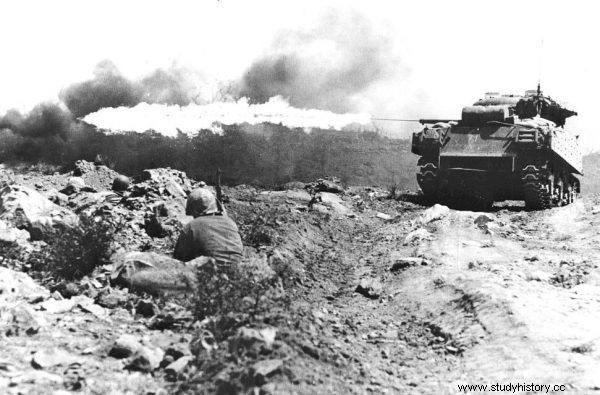
Only in the case of Americans and British Commonwealth soldiers was it possible to establish an official number of victims of the war. The photo shows the American marines during the fight for Iwo Jima (photo:Mark Kauffmanl; license public domain).
On the other hand, for many years in Poland, textbooks, articles and propaganda slogans gave the number of 6 million 28 thousand Polish victims of the war. It was not the result of scientific research, but a mere invention. In 1946, the then Undersecretary of State in the Presidium of the Council of Ministers, Jakub Berman arbitrarily stated that six million had died. And to create an appearance of realism, he added twenty-eight thousand.
From 30,000,000 to 60,000,000
According to calculations by Western historians, the total number of victims of World War II is between 35 and 60 million killed. Such data can be found, for example, in the above-mentioned work World War II:People, Politics, and Power . They are also repeated in the development of World War II edited by Alisha Bains.
In turn, in the American World War II:The Encyclopedia of the War Years 1941-1945 Norman Polmar and Thomas B. Allen, we read that, according to the compilation of data from several international agencies presented in the Vatican in 1946, 22.06 million people (soldiers and civilians) died and 34.4 million were injured.
Another American publication - The Real History of World War II:A New Look at the Past Alan Axelrod - reports that between 30 and 50 million civilians died during the war. British military historian Jeremy Black in his book World War Two:A Military History it lists 21 million soldiers killed and over 38 million civilians killed. All publications cited here state that it is impossible to establish the exact number of victims and that the data provided is only approximate.
Loss is beyond human comprehension
Let us now give the floor to the well-known and respected British historian Ian Kershaw. In his latest book To Hell and Back. Europe 1914-1949 ” he states that the number of victims of World War II in Europe alone exceeded 40 million and was more than four times higher than in World War I. Losses are beyond human comprehension. More than 25 million people died in the Soviet Union alone. The number of killed Germans reaches about 7 million. Poland lost 6 million citizens - states the historian.
Kershaw writes that the countries of Eastern and Southern Europe (Balkans) suffered the greatest losses, because the war was the most brutal there. Fate and history treated Western Europe more gently:
Total casualties of all allies during the Second World War, they totaled just over 14 million dead (excluding civilian casualties). Of this, Great Britain (and its overseas territories) accounts for around 5.5% of this number, France (with colonies) around 3%, and the USSR around 70% . (…)
Less than 70,000 civilians died in the bombing of British cities. On the other hand, losses among civilians in the very center of this Nazi death cyclone - that is, in Poland, Ukraine and Belarus, as well as in the Baltic countries and in the western parts of the Soviet Union - are incomparably higher, as the number of casualties among them amounted to about 10 million.
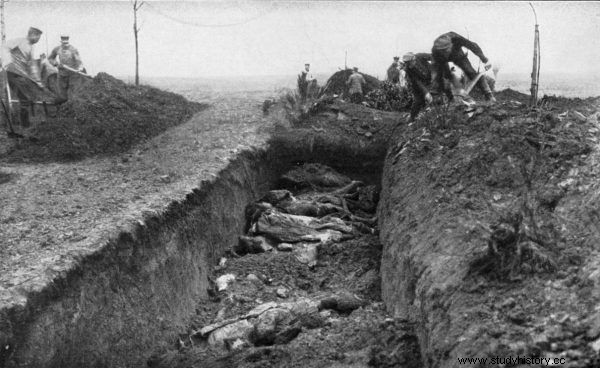
During World War II, four times more people died in Europe alone than the Great War claimed. In the photo, German soldiers cover a mass grave of English and Australian soldiers. 1916 or 1917 (photo:Hermann Rex; lic. Public domain).
43,000,000 killed!
In turn, Norman Davies in his work "Europe is fighting 1939-1945" states that the studies contain very different data on the number of victims of the last war:62 million (37 million civilians and 25 million soldiers), 38.2 million (24 million civilians and 14.2 million soldiers) and finally 25.95 million (16.6 million civilians and 9.3 million soldiers).
He himself is inclined to the figure of 28 million 288 thousand (broken down into losses recorded in the registers in Western Europe - 2.96 million, and estimated losses in the countries of Eastern and Southern Europe - 25.32 million). At the same time, he emphasizes that none of these calculations can be considered final, because many of their components are still questioned and subject to revision.
And indeed:in the book of the Russian researcher Boris Sokolov "Truths and myths of the Great Patriotic War 1941-1945" we read that thanks to new research by Russian historians from the 1990s and access to previously secret sources, the estimates of Soviet victims of World War II are changing. They may not reach 20 million people, as was claimed after the war, or even 27 million (to this level they were raised after the collapse of the USSR), but the sky-high 43.3 million people ...
50,000,000 killed!
One cannot forget about the Far Eastern theater of military operations. Historians recognize that World War II began here as early as 1937. As Antony Beevor writes in his "Second World War", there are also some researchers from Asia who shift the caesura as early as 1931, i.e. the moment when Manchuria was taken over by Japanese troops.
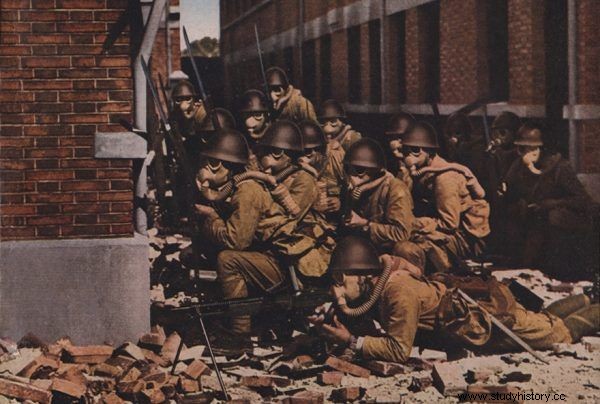
The beginning of World War II in the Far East was assumed to be the Japanese offensive in China in 1937. The photo shows Japanese soldiers during the fight for Shanghai (photo:Kokusai Joho Sha; lic. Public domain).
Later there were Soviet-Japanese border fighting in 1938-1939, and the global Far East conflict took on after the Japanese attack on the Asian possessions of Western countries in December 1941. It ended with the surrender of Japan on September 2, 1945.
The war in the Far East was very brutal (sometimes more brutal than in Europe) and cost the lives of more than 2 million people on the Japanese side and almost 22 million on the Allied side. China, struggling with Japan since 1937, suffered particularly severe human losses. The imperial army that occupied the Middle Kingdom committed many bloody and mass crimes there (such as the six-week-long massacre in Nanjing).
Antony Beevor reports that as a result of the hostilities in China, more than 20 million citizens of this country died (and 15 million were injured). The military losses are as follows:national forces of 3.2 million killed and wounded, communist forces 580 thousand killed and wounded.
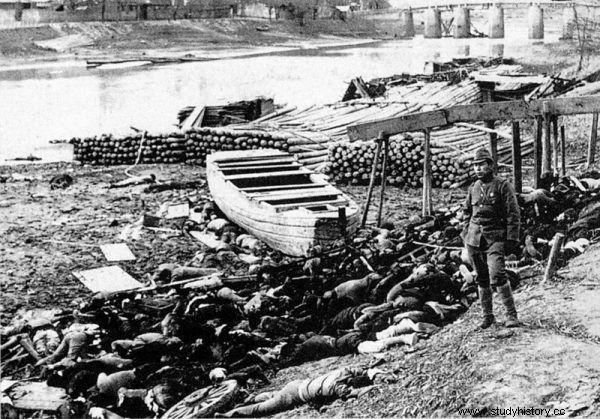
According to the latest estimates, 50,000,000 Chinese may have died during the war. In the photo of the victim of the Nanking massacre by the Japanese (photo:Originally Moriyasu Murase; lic. Public domain).
However, Chinese historians have recently estimated that many more could have been killed - nearly 50 million people! In turn - as we read in Beevor - from ten to ninety million people fled from the Japanese, and after the war they had nowhere to return to .
Worse, defeating Japan did not mean peace at all for China. A civil war began in the country, which lasted until 1949. China undoubtedly belongs, along with Poland, Germany and the USSR, to the countries that suffered the greatest (in relation to the entire population) human losses during the war.
The bodies of the dead disappeared
Why are there so many differences in the historians' calculations of the victims of World War II? The nature of the global conflict is to blame.
Its vastness, multidimensionality, as well as the type of means used to kill it, made it impossible to record all the deaths that occurred. Establishing the number of civilian victims of carpet raids, artillery shelling of towns and villages, accidental fire or direct fighting in an inhabited area was very often impossible for purely practical reasons.

In the situation of the ongoing fierce struggle, no one had the time, and often no opportunity, to deal with registering the victims. Not to mention the fact that in some cases the bodies of the dead simply disappeared, as was the case, for example, in German cities engulfed in firestorms after bombing raids.
The executioners did not count the victims
The victims were not always counted during the mass crimes committed by the warring parties:shootings, killings, burning alive. To this day, there is a dispute between historians about the number of Polish victims of the Volhynia massacre, and the differences in the figures quoted sometimes reach 40,000 people.
It also happened that the transports of Jews destined for extermination arriving at the German extermination camps were not registered (contrary to the opinion of German scrupulousness), but were immediately sent to the gas chambers.
On the other hand, historians estimate the number of civilian victims of the Warsaw Uprising at 150,000 to 200,000. The difference is - a trifle - 50,000 people. Let us add that just after the war, the number of inhabitants of the capital killed in the uprising was estimated at 700,000. There are many more examples of such huge differences in estimates.
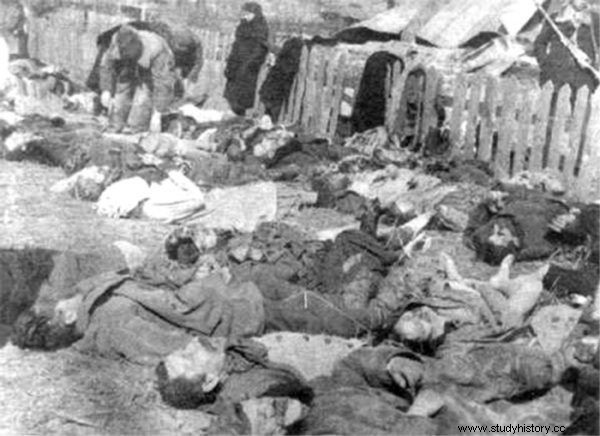
In the case of the Volhynia Massacre, the discrepancies as to the number of victims reach 40,000 people. The photo shows the murdered inhabitants of Lipniki (source:public domain).
Armageddon of Europe
There are also difficulties in determining the number of victims who died not as a result of direct warfare, but phenomena accompanying war:hunger, disease, poverty, banditry, etc. As Ian Kershaw, already mentioned here, writes in his book "To hell and back. Europe 1914-1949 ” :
The high mortality rate among civilians was the result of the genocidal nature of World War II, as it was the attempt to eliminate entire communities, unknown during the 1914-1919 war, that caused the great conflagration . It was like descending into an abyss of nothingness that had never happened before in history, a complete rejection of all the ideals of civilization that had played a part in shaping societies since the Enlightenment. It was a war of apocalyptic proportions. Armageddon of Europe.
All of this makes it simply impossible to determine the exact number of dead and dead people.
Killed or missing?
It seems easier to determine the number of soldiers killed. By nature, they were recorded, and losses incurred by units in combat - counted. Although it was not always possible to recreate the fate of everyone who disappeared from the ranks and their body was not found here. In such cases, the term "missing" was used.
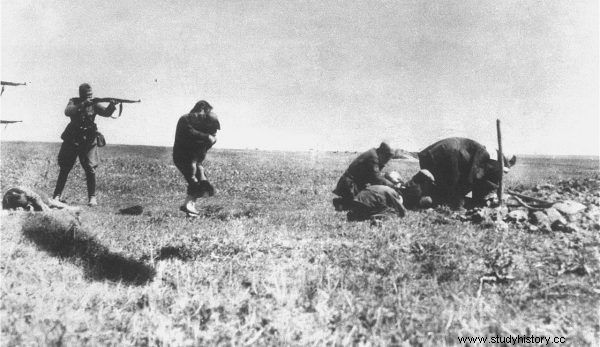
Estimating the exact number of victims among the citizens of the Soviet Union raises a lot of debate to this day. The photo shows the execution of Kiev Jews by the German Einsatzgruppen troops (source:public domain).
In addition, the largest military force participating in this conflict - the Red Army - did not use military identifiers called dog tags since 1942. The Germans, on the other hand, did not always keep records of millions of Soviet soldiers taken prisoner and then starved in POW camps. Hence the real difficulties in establishing the real losses of the Red Army.
Polish, Soviet or Belarusian victims?
Another serious obstacle is the methodology to be applied when counting the casualties of World War II. Killed Poles from the Eastern Borderlands should be counted as Polish, Soviet, Belarusian or maybe Ukrainian victims? After all, the national and ethnic affiliation of these areas was not obvious. Similarly with those killed in the USSR:in the post-war years they were counted together and referred to as "Soviet victims of the war."
However, after 1990, they began to be divided into individual nationalities that had the misfortune to find themselves within the borders of Stalin's state. Norman Davies in his book "Europe is fighting 1939-1945" gives the following data on about 18 million Soviet casualties among the civilian population (approximately):2 million Jews, 1-2 million Poles, 2-3 million Russians, 2-3 million million Balts, 3-4 million Belarusians and 5-8 million Ukrainians.
An attempt to count the murdered Jews of Europe presents a similar problem:should they be counted among the losses of individual states and nations, or should they be treated separately? What about the countries that exist today and were not there during the war (such as Serbia)? And what about the victims of Soviet labor camps and Stalinist terror killed during the war? There are plenty of such methodological questions.
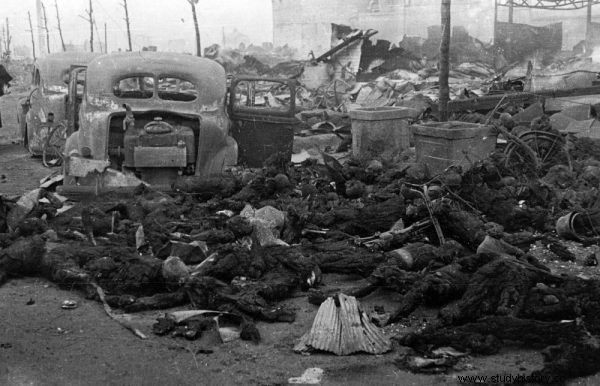
We will probably never know the exact number of victims of World War II. Pictured here is the charred bodies of the Tokyo people who died as a result of an American air raid carried out on the night of March 9-10, 1945. According to some estimates, as many as 100,000 civilians may have died there (photo:Shikawa Kōyō; lic. Public domain).
Estimates, estimates, estimates
Thus, historians' calculations regarding the victims of World War II are estimates. This is what the Russian historian Borys Sokolov writes about it:
By determining human casualties in a short-lived and limited-scale armed conflict in which the number of casualties is in the hundreds or a few thousand at most, you can almost be sure that the number of casualties given in the source documents are similar to the real ones. The situation is different when the war lasts for several years and the number of killed and wounded reaches millions and tens of millions of lives.
Then the researcher is unable to comprehend the mass of source loss reports, which often underestimate and sometimes overestimate the actual number of victims. The historian is therefore doomed to make estimates, and the greater the number of victims, the greater the margin of error .
And this is what it is like when trying to calculate the victims of World War II. We will never know their exact number.
